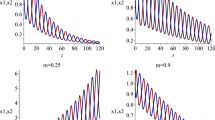Summary
The theory discussed in the first two papers, I and II, of this series is here generalized so that it is applicable to a population which obeys, at each instant t, the following two assumptions: (i) the rate- Dx(a, t) at which the population loses individuals of age a through death and dispersal is given by a function γt of a and the number x(a, t) of individuals which have age a, i.e.-Dx(a, t)=γt(x(a, t), a) and (ii) the number x(0, t) of newly born individuals is given by a function Ft of the number x(af, t) of individuals at a specified age af of fecundity, i.e. x(0, t)=Ft(x(af, t)). The ‘autonomous case’ in which the functions γt and Ft are independent of the subscript t corresponds to the theory developed in I and II. The present article contains a treatment of the case in which the population is in a ‘periodic environment’ in the sense that the mapping t ↦ (γt, Ft) is periodic with a period which is an integral multiple N of af. Under the assumption that for each pair (t, a) the function γt(·, a) is convex and the function Ft(·) is strictly increasing and concave, it is shown that when the environment is periodic, a given population can be expected to belong to one of three classes, regardless of initial conditions: (A) the class of ‘endangered populations’ for which the abundance function x eventually decays to zero, (B) the class of ‘asymptotically periodic populations’ for which as time increases x approaches a non-zero function x* which is periodic in time with period Naf, and (C) the class of populations which exhibit unbounded growth. The properties of the loss functions γt and fecundity functions Ft which determine the class to which a population belongs are found and discussed, and formulae are given for the stable periodic abundance function x* of a population in class B. In a discussion of the domain of application of the theory, it is pointed out that when reproduction is seasonal and is followed by mortality, the assumption that an individual interacts only with others of the same age is a reasonable one.
Similar content being viewed by others
References
Coleman, B. D.: On the Growth of Populations with Narrow Spread in Reproductive Age: I. General Theory and Examples. (Here referred to as ‘I’.) J. Math. Biology 6, 1–19 (1978)
Coffman, C. V., and Coleman, B. D.: On the Growth of Populations with Narrow Spread in Reproductive Age: II. Conditions of Convexity. (Here referred to as ‘II’.) J. Math. Biology 6, 285–303 (1978)
Hartman, P.: Ordinary Differential Equations. New York: Wiley 1964 (or see the recent enlarged edition: Baltimore, 1973)
Author information
Authors and Affiliations
Additional information
This research was supported by the U.S. National Science Foundation.
Rights and permissions
About this article
Cite this article
Coffman, C.V., Coleman, B.D. On the growth of populations with narrow spread in reproductive age: III. Periodic variations in the environment. J. Math. Biology 7, 281–301 (1979). https://doi.org/10.1007/BF00275729
Received:
Issue Date:
DOI: https://doi.org/10.1007/BF00275729




